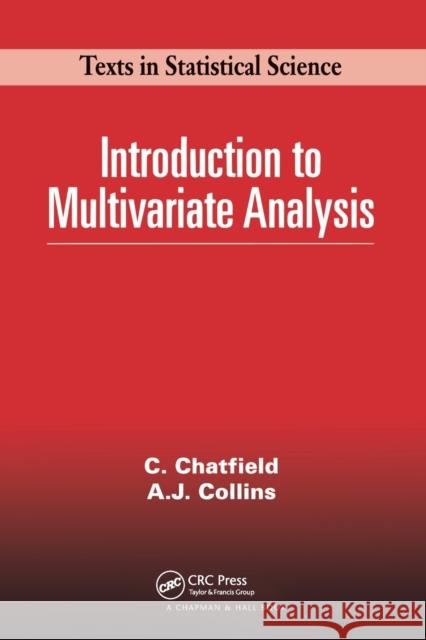Introduction to Multivariate Analysis » książka



Introduction to Multivariate Analysis
ISBN-13: 9780412160400 / Angielski / Miękka / 1981 / 248 str.
Introduction to Multivariate Analysis
ISBN-13: 9780412160400 / Angielski / Miękka / 1981 / 248 str.
(netto: 464,55 VAT: 5%)
Najniższa cena z 30 dni: 478,50
ok. 22 dni roboczych
Bez gwarancji dostawy przed świętami
Darmowa dostawa!
This book provides an introduction to the analysis of multivariate data
"The book's simplicity of approach and clear presentation make it a good choice for an undergraduate course or a self-study course in multivariate analysis."
-Journal of the American Statistical Association
"The original aims of the book are fulfilled remarkably well, thus providing a text which is to be welcomed into an area where there has been a recent dearth of introductory material."
-BIAS
Preface
Part One: Introduction
1 Introduction
Examples
Notation
1.1 Review of Objectives and different approaches
1.2 Some general comments
1.3 Review of books on multivariate analysis
1.4 Some matrix algebra revision
1.5 The general linear model
Exercises
2 Multivariate distributions
2.1 Multivariate, marginal and conditional distributions
2.2 Means, variances, covariances and correlations
2.3 The multivariate normal distribution
2.4 The bivariate normal distribution
2.5 Other multivariate distributions
2.5.1 Multivariate discrete distributions
2.5.2 Multivariate continuous distributions
Exercises
3. Preliminary data analysis
3.1 Processing the data
3.1.1 Data editing
3.2 Calculating summary statistics
3.2.1 Interpreting the sample correlation matrix
3.2.2 The rank of R
3.3 Plotting the data
3.4 The analysis of discrete data
Exercises
Part Two: Finding New Underlying Variables
4. Principal component analysis
4.1 Introduction
4.2 Derivation of principal components
4.3.1 Principal components from the correlation matrix
4.2.2 Estimating the principal components
4.3 Further results on PCA
4.3.1 Mean-corrected component scores
4.3.2 The inverse transformation
4.3.3 Zero eigenvalues
4.3.4 Small eigenvalues
4.3.5 Repeated roots
4.3.6 Orthogonality
4.3.7 Component loadings/component correlations
4.3.8 Off-diagonal structure
4.3.9 Uncorrelated variables
4.4 The problem of scaling in PCA
4.5 Discussion
4.5.1 The identification of important components
4.5.2 The use of components in subsequent analyses
4.6 PCA for multivariate normal data
4.7 Summary
Exercises
5. Factor analysis
5.1 Introduction
5.2 The factor-analysis model
5.3 Estimating the factor loadings
5.4 Discussion
Part Three: Procedures Based on the Multivariate Normal Distribution
6. The multivariate normal distribution
6.1 Introduction
6.2 Definition of the multivariate normal distribution
6.3 Properties of the multivariate normal distribution
6.4 Linear compounds and linear combinations
6.5 Estimation of the parameters of the distribution
6.6 The Wishart distribution
6.7 The joint distribution of the sample mean vector and the sample covariance matrix
6.8 The Hotelling T²-distribution
Exercises
7. Procedures based on normal distribution theory
7.1 Introduction
7.2 One-sample procedures
7.3 Confidence intervals and further analysis
7.4 Tests of structural relations among the components of the mean
7.5 Two-sample procedures
7.6 Confidence intervals and further analysis
7.7 Tests of structural relations among the components of the means
7.8 Discriminant analysis
Exercises
8. The multivariate analysis of variance
8.1 Introduction
8.2 MANOVA calculations
8.3 Testing hypotheses
8.3.1 The special case: The univariate procedure
8.3.2 The multivariate model for Example 8.1
8.3.3 Multivariate test procedure
8.3.4 Distributional approximations
8.3.5 Applications of the methodology
8.4 Further analysis
8.5 The dimensionality of the alternative hypothesis
8.6 Canonical variates analysis
8.7 Linear functional relationships
8.8 Discriminant analysis
Exercises
9. The multivariate analysis of covariance and related topics
9.1 Introduction
9.2 Multivariate regression
9.2.1 The special case: Univariate multiple regression
9.2.2 The general case: Multivariate regression
9.3 Canonical correlation
9.4 The multivariate analysis of covariance
9.4.1 The special case: Univariate analysis of covariance
9.4.2 The multivariate case: An example
9.4.3 The multivariate case: General results
9.5 The test for additional information
9.6 A test of an assigned subset of linear compounds
Exercises
Part Four: Multidimensional Scaling and Cluster Analysis
10. Multidimensional scaling
10.1 Introduction
10.2 Measures of similarity and dissimilarity
10.2.1 Similarity coefficients for binary data
10.3 Classical scaling
10.3.1 The calculation of co-ordinate values from Euclidean distances
10.3.2 The relationship between classical scaling and principal component analysis
10.3.3 Classical scaling for a dissimilarity matrix
10.3.4 Interpretation of the results
10.3.5 Some related methods
10.4 Ordinal scaling
10.4.1 The iterative procedure
10.4.2 Interpreting the results
10.5 A comparison
10.6 Concluding remarks
Exercises
11 Cluster analysis
11.1 Introduction
11.1.1 Objectives
11.1.2 Clumping, dissection and clustering variables
11.1.3 Some other preliminary points
11.2 Visual approaches to finding a partition
11.3 Hierarchical trees
11.4 Single-link clustering
11.5 Some other clustering procedures
11.5.1 Method or algorithm?
11.6 A comparison of procedures
11.6.1 Some desirable conditions for hierarchical clustering methods
11.6.2 A comparison
Exercises
References
Answers to exercises
Name Index
Subject Index
Chris Chatfield
1997-2025 DolnySlask.com Agencja Internetowa
KrainaKsiazek.PL - Księgarnia Internetowa









